
Andy Lloyd's Dark Star Blog

Blog 57 (December 2017)
Return of the Pioneer Anomaly
One of the many pieces of evidence put forward for the existence of Planet X over the last few decades is the so-called 'Pioneer anomaly'. The two Pioneer spacecraft were sent on an incredible voyage across the solar system, visiting a number of planets as they went. They not only imaged these planets, but used the gravity of the planets to accelerate onwards, deeper into the solar system. This gravity assist is often used to allow spacecrafts to pick up speed. As the Pioneer probes travelled across the outer planetary zone and on towards the Heliopause beyond in the 1990s, it became apparent that the craft were not moving away from the solar system quite as quickly as the theoretical trajectory projections demanded. Something was essentially slowing them down. Additionally, similar effects were noted for the Galileo and Ulysses probes.
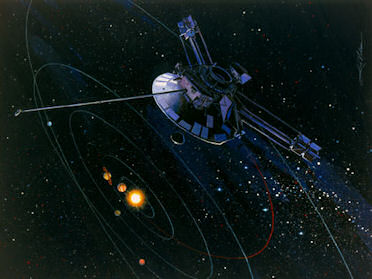
Image credit: Artist impression, NASA
Many ideas were put forward, including either gravitational or physical interaction with clouds of interplanetary dust in the Kuiper Belt, or even the added gravitational tug of an undiscovered Planet X body. One of the lead researchers into the Pioneer anomaly at the Jet Propulsion Laboratory was John Anderson (1), who, interestingly, also had a longstanding interest in the possible existence of a Planet X body (2). At one point, puzzled physicists began to wonder whether this marginal but definitive anomaly might require new laws of physics (3). In the end, it was agreed by technical experts that the anomalous deceleration was a result of radiation pressure caused by non-uniform heat loss from the probes (4,5). Flights of fancy about missing planets and new physics were promptly put to bed.
Despite this, the anomaly seems to persist in the increasingly accurate navigation and telemetry data returning from various spacecraft performing flybys past the Earth (6). Similarly, the Juno spacecraft, now orbiting fairly closely around Jupiter, is reported to be slightly misplaced from its expected position (7). This has been determined by looking at the Doppler shift of ranging data from the probe as it circumnavigated the poles of the great gas giant. Quixotically, Juno did not exhibit the same anomalous behaviour during a previous flyby of Earth. This suggests that this is not, then, the result of an internal machination of the probe itself, as described for the Pioneer probes. Instead, there does appear to be an unexplained external effect worth exploring:
"Another mystery is that while in some cases the anomaly was clear, in others it was on the threshold of detectability or simply absent – as was the case with Juno‘s flyby of Earth in October of 2013. The absence of any convincing explanation has led to a number of explanations, ranging from the influence or dark matter and tidal effects to extensions of General Relativity and the existence of new physics. However, none of these have produced a substantive explanation that could account for flyby anomalies." (8)
I was intrigued by two possibilities. The first is that the gravitational tug experienced by these spacecraft is ever so slightly affected by a non-uniform cross-section of the planet. In other words, the Earth might provide a slightly variation in gravitational attraction, local to a spacecraft flying over it, depending upon whether the interior mass of our planet is slightly offset - or, at least, has areas of high interior density which are not uniformly distributed. While I could see this being a possibility for a rocky planet like Earth, with its diversity of internal composition and layers and overall non-spherical 'geoid' shaping, it's more difficult to see how that might be the case for a gas giant, like Jupiter, whose interior would surely be more uniformly distributed. Indeed, the team studying the trajectories of Juno's polar orbits of Jupiter accounted for Jupiter’s multipolar fields, which are the result of the planet's oblate shape.
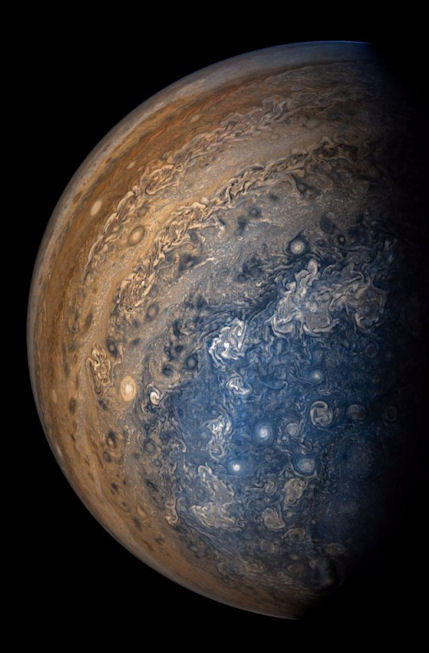
Image credit: NASA/JPL-Caltech/SwRI/MSSS/Gerald Eichstädt/Seán Doran
A look through research literature on the subject of how planetary gravitational fields vary with planetary structure and shape quickly descends into a world of mathematical pain. Surely, somewhere in the discussion of zonal gravity coefficients and spherical harmonics lie the solution to these flyby issues? I wrote to Dr Acedo to enquire further, and received this helpful response to my question:
(1) Could these anomalous accelerations be due to a non-uniform planetary interior creating slight gravitational differences affecting the craft during a flyby?
"Of course, they could arise from the longitudinal non-uniformities in the gravitational field of the planets. These are characterized by the so-called tesseral harmonics and I showed that a rotating planet with longitudinal non-uniformities can transfer energy to the spacecraft in a previous paper (9). However, they are not enough (in the case of the Earth, at least) to explain away the anomalies. For Jupiter, It is still an open question and we have to await for a full analysis of the Juno's orbital data at JPL because the conclusions in the paper are based on preliminary fits and our knowledge of Jupiter's gravitational field is much more incomplete than that of the Earth." (10)
My second thought is that probes moving through trajectories that are not along the plane of the ecliptic might be more susceptible to slight gravitational perturbations created by unknown planets which themselves lie substantially off the ecliptic. So, for instance, the proposed Planet Nine body (11) is thought to be inclined from the ecliptic by thirty degrees or so. This might drive anomalies in the solar system's overall angular momentum vectoring away from the general plane of the planets. For this to even be a possibility, it would be crucial to know whether these effects are more likely to happen with polar flybys than with equatorial ones - in other words, is there an effect felt perpendicular to the ecliptic?
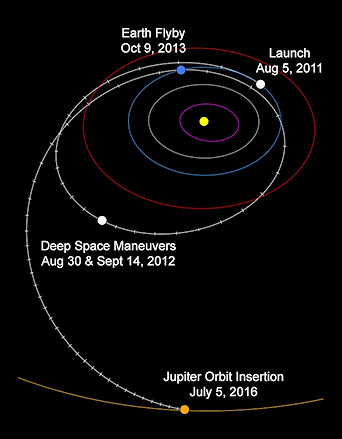
Image credit: NASA
Again, I asked Dr Acebo as to whether this was the case:
(2) Do these anomalies show up more with polar flybys ... or, at least, flybys which are not sticking to the ecliptic plane?
"Yes, polar flybys seems more prone to show large anomalies than equatorial orbits but this is a very qualitative classification. For example, the largest anomalies were found for the NEAR flyby on 1998 whose orbit was close to be contained in a plane perpendicular to the equator so the orbit orientation seems to play a role in the magnitude and sign of the anomalous velocity change. Altitude over the Earth surface is also an important factor." (10)
That seems to keep the possibility alive, at least, although it's far from conclusive evidence of a distant gravitational tug. But how massive would a distant planet need to be to provide even this slight deviation? Too large, according to Dr Acedo, in further correspondence with me:
"...the effect of a hypothetical 'Planet Nine' in the interior Solar System is not easy to measure and it has no significant contribution to the flyby anomaly. In the Astrophys. Space Sci. paper I considered the effect of the tidal forces exerted by Jupiter on a flyby of the Earth and dismissed it because its contribution to the anomalous velocity change is not comparable with the observations (6)
, the same can be said of 'Planet Nine'. I also remember a paper by Lorenzo Iorio in which he studied the perturbations of a new planet in connection with the lingering anomaly of the Moon's orbit varying eccentricity (12). But to explain this he concluded that it would require a Jupiter-like planet at 200 AU that it is much larger than the estimated size of 'Planet Nine'. Summarizing, anomalies in the inner solar system (if they are real and not the result of measurement and modelling errors) cannot be accounted by new trans-neptunian planets." (13)These probes which have exited the solar system offer so much beyond the glorious array of images they sent back during their main missions. In the case of Pioneer, questions were raised (and seemingly continue to be raised) about fundamental physics. The tenacity of the Voyagers can be seen through their ability to respond to new thruster demands decades after these systems went into hibernation, potentially extending their missions even further (14).
Finally, after its flyby of Pluto and Charon, the New Horizons probe is set to approach the Kuiper Belt Object known as 2014 MU69 late next year, making its flyby on 1st January 2019. Originally thought to be about 20 miles across, recent attempts to analyse the size of 2014 MU69 as it passed in front of a background star proved difficult. Although detected by several groups of astronomers during this transit, 2014 MU69 appears to either much smaller than originally thought, or could be a binary object, or even a swarm of smaller objects (53). These exiles from our solar system continue to surprise.
Written by Andy Lloyd, 5th December 2017
References:
1) John Anderson et al "Study of the anomalous acceleration of Pioneer 10 and 11" April 2001, Physical Review D 65(8)
2) John Noble Wilford 'Looking for Planet X: Old clues, new theory' 1 July 1987
3) Robert Matthews "Mysterious force holds back Nasa probe in deep space" 10 February 2002
4) Edward Murphy 'Prosaic Explanation for the Anomalous Accelerations Seen in Distant Spacecraft' Phys. Rev. Lett., 30 August 1999, 83, 1890
5) B. Rievers & C. Lämmerzahl "High precision thermal modelling of complex systems with application to the flyby and Pioneer anomaly" 5th May 2011, Annalen der Physik, 523 (6): 439.
6) Luis Acedo 'Anomalous accelerations in spacecraft flybys of the Earth', Astrophysics and Space Science, 362(12), November 2017
7) L. Acedo, P. Piqueras and J. Morano "A possible flyby anomaly for Juno at Jupiter" Universitat Politecnica de Valencia, 27 November 2017
https://arxiv.org/pdf/1711.08893.pdf
8) RAS-WEB "Juno Isn’t Exactly Where it’s Supposed To Be. The Flyby Anomaly is Back, But Why Does it Happen?" The Renfrewshire Astronomical Society, with thanks to Lee
renfrewshireastro.co.uk article
9) L. Acedo "On the effect of ocean tides and tesseral harmonics on spacecraft flybys of the Earth" MNRAS, 63: 2, p.2119-2124,
10) Correspondence from Luis Acedo, 11 December 2017
11) K. Batygin & M. Brown "Evidence for a Distant Giant Planet in the Solar System" 20 January 2016, The Astronomical Journal, 151: 2,
12) Lorenzo Iorio "On the anomalous secular increase of the eccentricity of the orbit of the Moon" Monthly Notices of the Royal Astronomical Society, 1st February 2011, 415: pp1266-1275,
13) Correspondence from Luis Acedo, 12 December 2017
14) Leah Crane "NASA fires Voyager 1’s engines for the first time in 37 years" 5 December 2017, with thanks to Monika
15) Jay Bennett "New Horizons Spacecraft On Its Way to Mysterious Kuiper Belt Object" 7 July 2017
Dwarf Star Planets lack Polar Ozone
We're used to the concept of holes in the ozone layer on our own planet. But it may be far worse on planets orbiting red or brown dwarf stars. potentially habitable planets orbiting these stars may be located so close to their parent stars that they are tidally locked, causing the same face of the planet to forever gaze upon the star. This is the same effect as our Moon facing the Earth - the lunar rotation matches its orbital period around the Earth. But in the case of a planet orbiting a small dwarf star, this has implications for the way any light and radiation arrives at the planet. Without a rotation of its surface relative to the star, the same hemisphere of the planet will face the star. One side of the planet in is continual daylight, one night. This would like cause extremes of climate across the globe, tempered by atmospheric movement.
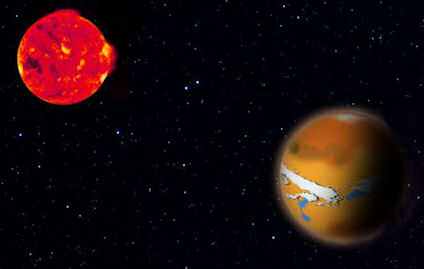
Image credit: MPIA Graphics Department
That said, this also potentially sets up a very different meteorological system on the exoplanet. New modelling of stratospheric circulation of Earth-like exoplanets orbiting dwarf stars, particularly in less than 25 days, indicates that ozone, in particular, may be distributed very unevenly across the surface of the world. In the case of photochemically produced gases, like ozone, these may be confined to an equatorial transport belt, and may never get distributed into the polar regions of the planet at all (1).
"Modelling the flow of air within the atmospheres of these planets, [Ludmila] Carone [of the Max Planck Institute for Astronomy in Germany] and her colleagues found that this unusual day-night divide can have a marked effect on the distribution of ozone across the atmosphere: at least for these planets, the major air flow may lead from the poles to the equator, systematically trapping the ozone in the equatorial region. Carone says: "Absence of traces of ozone in future observations does not have to mean there is no oxygen at all. It might be found in different places than on Earth, or it might be very well hidden."
Such unexpected atmospheric structures may also have consequences for habitability, given that most of the planet would not be protected against ultraviolet (UV) radiation. "In principle, an exoplanet with an ozone layer that covers only the equatorial region may still be habitable," Carone explains. "Proxima b and TRAPPIST-1d orbit red dwarfs, reddish stars that emit very little harmful UV light to begin with. On the other hand, these stars can be very temperamental, and prone to violent outbursts of harmful radiation including UV." (2)
So, how about Earth-like planets orbiting around tiny brown dwarfs? The proximity of the habitable planet would need to be much closer -closer to the Moon's distance from the Earth than, say, Mercury from the Sun distance. The powerful tidal forces felt by the exoplanet would quickly whip it into a very constrained orbital and rotational pattern:
"A planet close to a brown dwarf feels very strong tides (from the brown dwarf, not any kind of moon — large moons are not stable for planets close to brown dwarfs). Tides affect the planet’s orbit and spin. The planet’s obliquity is quickly driven to zero, such that the equator is lined up with the orbital plane. The planet’s orbit becomes perfectly circular. And the planet tidally “locks” and always shows the same face to the star." (3)
The ultraviolet output of brown dwarfs is less well known - these objects are much more difficult to detect and study than their larger red dwarf cousins. On the plus side, the absence of UV could be seen as a good thing for habitability, as too great an exposure to this form of radiation is harmful to life. On the other hand, UV drives chemical and biochemical processes, so is definitely welcome in small measures. It may be that in the case of red dwarfs, the combination of tidal locking and UV flaring is a dangerous combination. This may contrast with brown dwarfs, which could have a much milder exposure to UV, undaunted then by the tidally-locking effect. We simply don't know at this stage.
Written by Andy Lloyd, 8th December 2017
References:
1) L. Carone et al. "Stratosphere circulation on tidally locked ExoEarths", Monthly Notices of the Royal Astronomical Society, 473(4): pp4672–4685, 25 October 2017,
academic.oup.com/mnras article
2) PhysOrg "Traces of life on nearest exoplanets may be hidden in equatorial trap" 29 November 2017
3) Sean Raymond "Real-life sci-fi world #4: Earth around a brown dwarf" 9 October 2014
Martian Worms
The potential viability of Mars as a habitat for humans involves a great many difficult challenges. Climate, air composition, resources, to name just a few. The ability to grow food using the Martian soil, or regolith, is one potential issue. Although the mineral constituents of the Martian soil are less sharp and rough than those found on the Moon, they are still sharper than those generally found in soil on Earth (1). Mars, after all, experiences weather, with dust storms in particular creating weathering effects upon the surface regolith. Also, mars had a watery past, which would also have contributed towards surface erosion, and a softening up of these minerals.
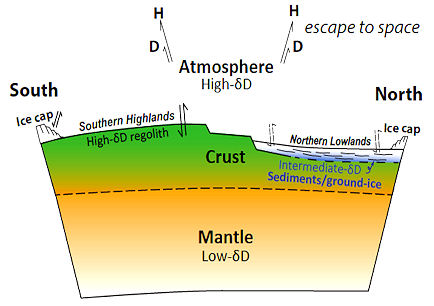
Image credit: NASA
Which raises the question - could Martian soil offer a viable basis for creating an ecosystem within which to grow food? Worms play an important role in processing soil constituents. They swallow soil, passing the mineral components safely through their guts. But if the soil constituents are too sharp, then this natural process will endanger their life. Researchers have simulated Martian regolith in laboratory experiements, mixing it with manure for a bit more vitality. The introduced worms into this 'alien' environment to see how the blighters got on. Well, it turned out, with the worms managing to reproduce quite happily (2).

This is, of course, very different from saying worms could survive on Mars, undaunted by the challenging environment of that planet. Apart from the very different atmospheric conditions, the lack of surface water and the extreme cold, there is no strong evidence of life having a foothold on Mars. If life's there at all, it's likely to be hidden under the surface, which makes worms a more likely denizen than most other possible species of Martian lifeforms (3). After all, Mars may have sub-surface icy lakes and/or oceans hidden under the regolith, like those on Jupiter's Galilean moons Europa and Ganymede (4).

Then there's the question of the fossilised wormlike-microorganisms thought to be a feature of Martian meteorite ALH84001 found in Antarctica, which were excitedly announced as a sign of alien life by NASA scientists in 1996 (5). This evidence for Martian microbial life remains contentious. Whether true or not, these nanobacteria are orders of magnitude smaller than the kinds of worms featuring in the biology experiments within regolith-like soil.
Written by Andy Lloyd, 8th December 2017
References:
1) Natasha Schön "Food for Mars: Will Worms survive the Martian and Lunar soils?" 8 August 2017
community.mars-one.com article
2) Lauren Sigfusson "Good News! Worms Make Babies in ‘Martian’ Soil" 4 December 2017, with thanks to Mattia
3) Zena Iovino "Gold-mine worm shows animals could be living on Mars" 2 June 2011
4) Dwayne Brown & William Jeffs "NASA, Planetary Scientists Find Meteoritic Evidence of Mars Water Reservoir" 18 December 2014
5) David Whitehouse "Martian rock 'does contain life'" 23 October 2017
Comet 67P Content is Carbon-rich
There's potentially good news for advocates of 'Panspermia'; the idea that life can be seeded across the Cosmos by interstellar comets, and other interacting cosmic bodies. The dust dislodged from the rubber-duck-shaped Comet 67P/Churyumov-Gerasimenko, which was investigated by ESA's Rosetta probe in 2014, is rich in relatively complex carbon-based compounds (1).
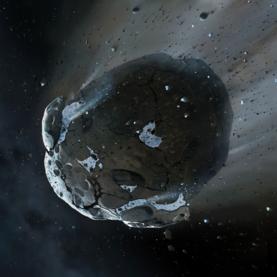
The carbon-based dust is dry, similar to the silicate-based dust alongside it:
"The whole composition, rich in carbon and non-hydrated minerals, points to a primitive matter that likely preserved its initial characteristics since the comet accretion in the outer regions of the protoplanetary disc." (2)
Previous recently published work has also highlighted the presence of very large macromolecular carbon-based compounds in the dust ejected from the comet during its perihelion passage (3). There is a consistency to the composition of the dust studied by Rosetta’s COmetary Secondary Ion Mass Analyser (COSIMA) instrument. The composition of 67P's dust is also consistent with that of comets 1P/Halley and 81P/Wild (2). This consistency implies that the nucleus of the comet also contains a significant proportion of carbonaceous materials, much of which takes the form of large organic compounds:
"According to the study, organic molecules (which are carbon-based molecules like proteins, carbohydrates, and nucleic acids) account for 45 percent of the total mass of all the collected dust... Therefore, if comets were responsible for seeding the early Earth with organic matter (as many researchers suggest), then these seeds may have already been somewhat complex by the time they reached Earth." (1)
This may be a bit of an exaggeration, as the types of compounds generally found in the dust lie on the organic end of the organic/biochemical spectrum, albeit likely in the form of large macromolecular compounds. The research also indicates that this carbon-rich material is dry - the water element of the comet, although present, is wrapped up as ice, precluding chemical interaction with the carbon-rich elements. Like the contents of a food freezer, they are separate, but stored together. There does not appear to have been much water-based chemistry going on within the comet. Nonetheless, the carbon-rich nature of this ancient cometary material raises the prospect that the organic macromolecular building blocks of life were indeed delivered to the Earth (2) - and to all other planets in the solar system, too. All that's needed in those environments is the presence of liquid water to really get things going.
Written by Andy Lloyd, 11th December 2017
References:
1) Jake Parks "Organic molecules make up half of Comet 67P" 1 December 2017, with thanks to Mattia
2) Anaïs Bardyn et al. "Carbon-rich dust in comet 67P/Churyumov-Gerasimenko measured by COSIMA/Rosetta." Monthly Notices of the Royal Astronomical Society, 469 Supp 2: ppS712–S722, 21 July 2017,
3) Nicholas Fray et al. "High-molecular-weight organic matter in the particles of comet 67P/Churyumov–Gerasimenko" Nature 538: 72–74, 06 October 2016, nature.com/article
Interstellar Shard Puzzles Astronomers
In October's Dark Star blog, I wrote about the first confirmed interstellar visitor to our solar system, known at that point as A/2017 U1 (1). The object, which had a reddish tinge to it, had proceeded through the solar system at quite a gallop. It failed to outgas a cometary tail, despite its precarious perihelion passage, which led astronomers to re-label the visitor as an asteroid rather than a comet. This inert nature is unusual, to say the least, and raised many questions. But astronomers had precious little time to examine this object in any great detail, its hyperbolic procession through the planetary zone being so transient.
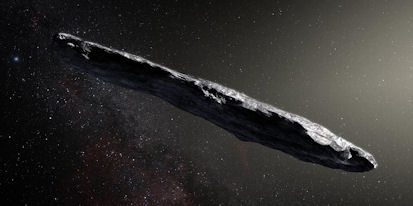
Image Credit: European Southern Observatory/M. Kornmesser
In addition to its reddish tinge, and lack of outgassing, the object notably exhibited a highly unusual variation in luminosity, allowing astronomers to deduce that this curious object has a rather odd shape. It appears as though the asteroid is shaped as a shard, and is tumbling head over heels on its axis every 7 hours or so.
Looking at this artist's impression of the interstellar object, which has been formally re-named 1I/2017 U1 (I for interstellar) and given the Hawaiian handle 'Oumuamua by its Pan-STARRs discoverers (2), you could be forgiven for thinking it bears some resemblance to a Star Destroyer from Star Wars. (Although objects in space do not need to be aerodynamic, a thin needle-like shape minimises the number of potential high-velocity collisions with grains of interstellar dust). This shape is unlike anything seen before in the solar system. It's true that many asteroids are mis-shaped, but never of these elongated proportions. This has led to some speculation about the origins of this weird and wonderful shard or rock and metal, which originates from somewhere near Vega (coincident with the solar apex, or the interstellar destination of the Sun as it moves through space).
One scientist considers 1I/`Oumuamua to be a fragment from a disintegrated planet - one that was rendered asunder by a dense member of a binary star system, like a red dwarf (3). Where the more familiar rounded rubble of our own solar system stems from collisional activity, the shard-like appearance of 1I/2017 U1 suggests a totally different origin - or at least the lack of cosmic 'weathering' in the interstellar environs it appears to have been tumbling through. It's hard to draw any firm conclusions from what little is known of this object, except that it is clearly very different from our familiar backyard comets and asteroids.
The object has drawn the attention of SETI researchers. Their 'Breakthrough Listen' team is planning to train a large radio telescope in West Virginia, US on 1I/`Oumuamua in an attempt to pick up artificial signals (4):
"Listen’s observation campaign will begin on Wednesday, December 13 at 3:00 pm ET. Using the Robert C. Byrd Green Bank Telescope, it will continue to observe ‘Oumuamua across four radio bands, from 1 to 12 GHz. Its first phase of observations will last a total of 10 hours, divided into four “epochs” based on the object’s period of rotation. ‘Oumuamua is now about 2 astronomical units (AU) away, or twice the distance between Earth and the Sun. This is closer by a factor of 50-70 than the most distant human artifact, the Voyager I spacecraft. At this distance, it would take under a minute for the Green Bank instrument to detect an omnidirectional transmitter with the power of a cellphone." (5)
One can understand the excitement, given the oddities of this object. Its hyperbolic trajectory for the solar apex, its cartwheeling spin, its shape, its lack of outgassing volatiles: All very unusual. This first known interstellar object also bears a little resemblance to the eponymous vessel in Arthur C. Clarke's novel 'Rendezvous with Rama' (6) - the fictitious visiting spacecraft which is initially considered to be an asteroid by astronomers. The scale is very different, though - 'Oumuamua's length is hundreds of meters, compared with Rama's 34 miles.
In the end, somewhat predictably, the elongated asteroid failed to display any signs of overt artificial intelligence (7). In a way, this question of alien presence served as a distraction from the real puzzle here - how did this interstellar asteroid get this weird shape? As yet, there is no definitive answer to this glaring issue.
Written by Andy Lloyd, 13-29th December 2017
References:
1) Andy Lloyd "Alien Red Asteroid Crashes Through Solar System" 28 October 2017
andylloyd.org/darkstarblog55.htm
2) Bill Dunford "1I/2017 U1 'Oumuamua: In Depth" NASA, 2017
3) Matija Ćuk "1I/`Oumuamua as a Tidal Disruption Fragment From a Binary Star System" 5 December 2017
4) Andrew Griffin "Huge object flying past earth may be alien spacecraft, scientists say" 12 December 2017
5) Breakthrough Initiatives “Breakthrough listen to observe interstellar object ‘Oumuamua” 11 December 2017
breakthroughinitiatives.org news
6) Arthur C. Clarke 'Rendezvous with Rama' Gollancz 1973
7) PhysOrg "No alien 'signals' from cigar-shaped asteroid: researchers" 14th December 2017, thanks to John
Sitchin Would Have Liked This
I had a particularly vivid dream last night, set in a scholarly environment - probably a college. The dream featured Zecharia Sitchin (1), playing the role of a visiting professor. I'd written a paper and was musing over its contents, and how best to present it. Sitchin seemed critical, insofar as I could tell his reaction at all. I guess whatever I was doing seemed a peripheral concern. This might sum up my whole Dark Star enterprise. Sitchin, now passed, was not a huge fan of what I was trying to present. Anyhow, as time has gone on, I've maintained an active interest in Planet X/Nibiru (writing this monthly blog, and slowly compiling a new book (2)), but tended towards the science side of things - perhaps even more than I had ten or twenty years ago - especially with the astrophysics etc. I remain hopeful that this object will one day be found, and be found to have a solid basis in everyday science.

The late Zecharia Sitchin
Sitchin was always interested in science, particularly when the technical prowess of the ancient civilisations of Mesopotamia were brought to light. He argued, passionately, that their myths, when read literally, exposed a deeply scientific appreciation for the composition and history of the solar system, more or less as we understand it now (he argues our current knowledge misses an important element which the ancients describe in some detail). In that vein, any indication of advanced Mesopotamian scientific understanding provided grist to his mill. And so it is, then, that the Babylonians appear to have mastered an important branch of geometry, hidden within their complex mathematical sexagessimal system. Their knowledge of trigonometry appears to have pre-dated the Greeks by about 1500 years (3).
If the scholars are correct (and they have their critics (4)), then this was a truly remarkable achievement. Figuring this out is also a remarkable achievement, not least because the format of the geometrical knowledge is not in the Western (Greek) style, but had to be teased out of the cuneiform script inscribed upon a famous clay tablet which dates to the Old Babylonian era, between the 19th and 16th centuries BCE, and is known as 'Plimpton 322'.

Plimpton 322, a 3700 year old Babylonian tablet held in the Rare Book and Manuscript Library at Columbia University in New York (1)
The discovery, announced back in the summer, opens up a wealth of possibilities:
“Plimpton 322 ... opens up new possibilities not just for modern mathematics research, but also for mathematics education. With Plimpton 322 we see a simpler, more accurate trigonometry that has clear advantages over our own. A treasure-trove of Babylonian tablets exists, but only a fraction of them have been studied yet. The mathematical world is only waking up to the fact that this ancient but very sophisticated mathematical culture has much to teach us.” (5)
Since then, a paper has been published, setting out the argument that Plimpton 322 is a powerful, exact ratio-based trigonometric table (4). The paper claims that the Old Babylonian system of exact ratios eliminates error, and is therefore potentially more advanced than the ancient Greek system of geometry we still make use of today (albeit with mind-numbingly higher degrees of accuracy):
"In addition to being historically significant, P322 also brings the founding assumptions of our own mathematical culture into perspective. Perhaps this different and simpler way of thinking has the potential to unlock improvements in science, engineering, and mathematics education today." (6)
Again, these claims are vigorously contested (2). But I think Sitchin would be smiling wryly at these developments in ancient Near Eastern studies (and maths?).
Written by Andy Lloyd, 29th December 2017
References:
1) Zecharia Sitchin "The Twelfth Planet" Avon Books 1976
2) Andy Lloyd "Darker Stars" Timeless Voyager Press, 2019
3) Jack Phillips "3,700-Year-Old ‘Mystery’ Babylonian Stone Tablet Is Translated" 20 September 2017, with thanks to Phil
4) Evelyn Lamb "Don't Fall for Babylonian Trigonometry Hype" 29 August 2017
scientificamerican.com_article
5) Deborah Smith "Mathematical mystery of ancient clay tablet solved " UNSW Press Release, 25 August 2017
6) Daniel Mansfield & N. Wildberger "Plimpton 322 is Babylonian exact sexagesimal trigonometry" Historia Mathematica, 44: 4, Nov. 2017, pp 395-419,

You can keep informed of updates by following me on Twitter:
![]()
Or like my Facebook Page: https://www.facebook.com/darkstarandylloyd